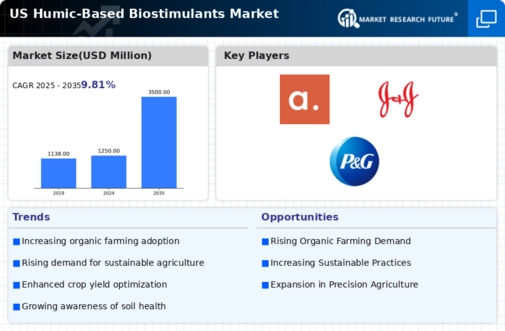The US Humic-Based Biostimulants Market has seen significant growth and competitive dynamics in recent years, driven by an increasing awareness of sustainable agriculture practices and the necessity for improving crop yields. As a result, numerous players are vying for market share, leading to innovations in product formulations and increased investments in research and development. The ecosystem consists of both established manufacturers and emerging enterprises, all striving to leverage the benefits of humic substances to enhance soil health, promote nutrient efficiency, and boost overall plant vigor.
Companies are focusing on their unique value propositions, which include organic and environmentally friendly methods of enhancing agricultural productivity while addressing both regulatory complexities and consumer demands.
Market Farm has established a strong presence in the US Humic-Based Biostimulants Market, primarily through its innovative product offerings that emphasize the enhancement of crop performance and soil quality. The company's dedication to R&D, coupled with strategic partnerships with agricultural producers, enables it to deliver tailored solutions that meet the unique needs of different crops and soil types. Leveraging its robust distribution network, Market Farm has successfully penetrated various regional markets, enhancing its competitive edge.
The company’s strengths lie in its ability to develop effective formulations that combine humic substances with other biologically active ingredients, leading to proven results in yield enhancement and pest resistance. By emphasizing sustainability and environmental stewardship, Market Farm appeals to the growing demographic of environmentally-conscious growers eager to adopt biostimulant technologies in their farming practices.
Haifa Group stands out in the US Humic-Based Biostimulants Market thanks to its extensive range of specialized products designed to optimize soil fertility and enhance plant health. The company promotes a diverse portfolio that includes humic acid, fulvic acid, and other organic biostimulants known for their efficacy in improving nutrient uptake and plant resilience. Haifa Group's strengths are manifested in its deep understanding of agricultural needs and the strategic formulation of its products, which cater specifically to the demands of the US market.
The company maintains a significant presence in key agricultural regions, supported by durable relationships with a vast network of distributors and end-users. Haifa Group has also engaged in strategic mergers and acquisitions to bolster its product offerings and technological capabilities, ensuring that it remains competitive in an evolving landscape. Through consistent innovation and a strong focus on customer service, Haifa Group continues to solidify its position as a key player in the US Humic-Based Biostimulants Market.














Leave a Comment